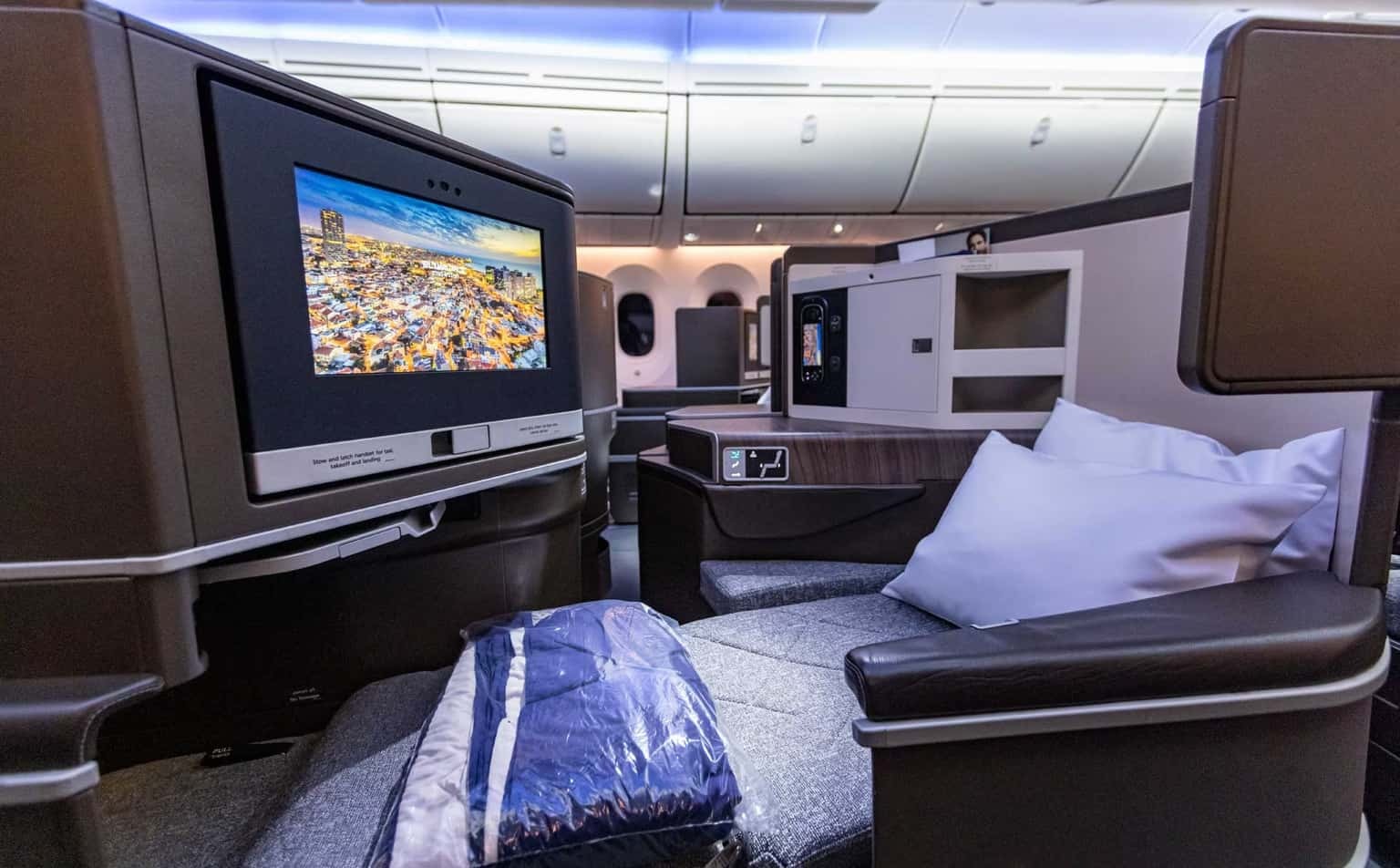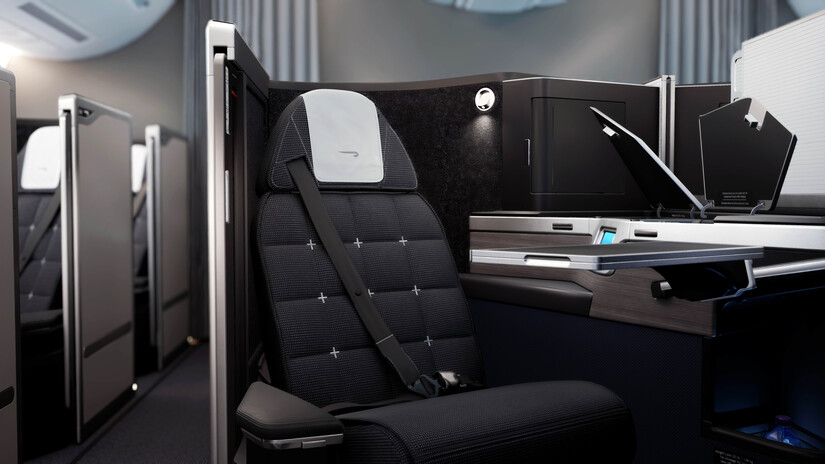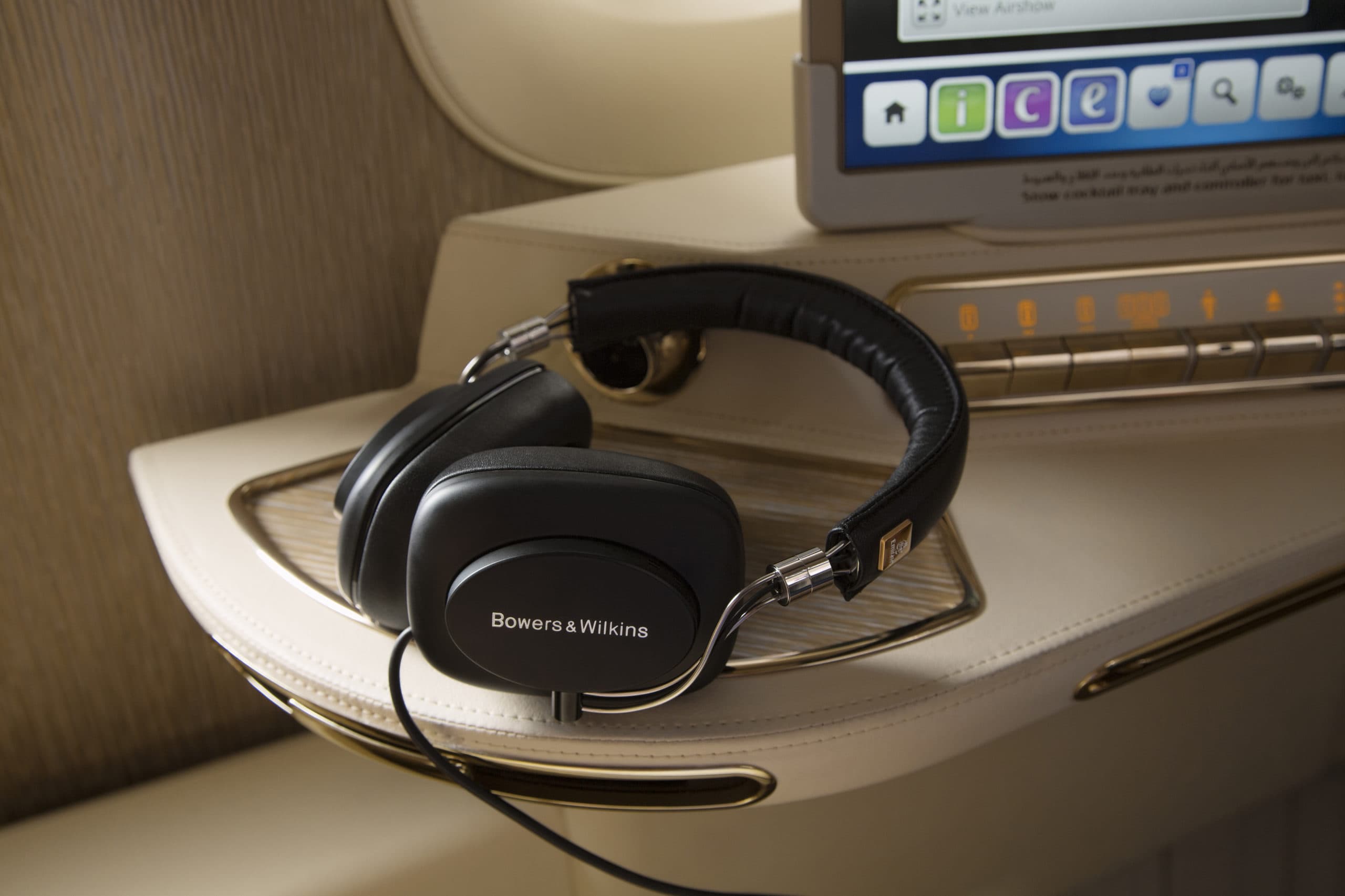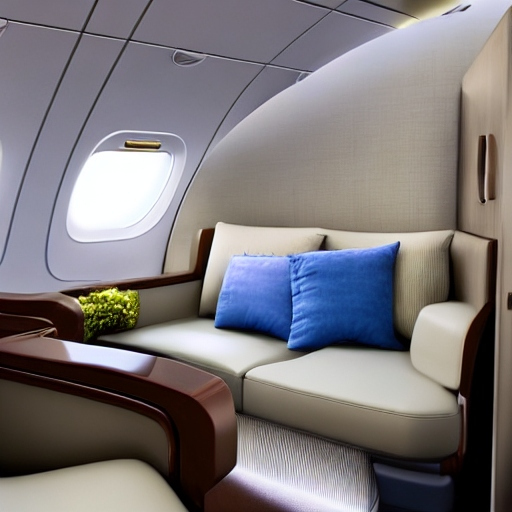With an up to 10 hour flight, here’s the comfort that you can expect and should make sure you’re getting.
Before the world was introduced to commercial aviation, sailing was the only way to cross the Atlantic Ocean. These transatlantic voyages often took days and were fraught with challenges. Unpredictable weather, rough waves, and contagious diseases were just some of the hazards faced by those brave enough to make the journey.
This all changed in the 20th century, as the first transatlantic commercial airplanes started taking flight. However, the challenges of crossing such long distances didn’t cease. They just evolved to new heights.
As modern-day passengers take this journey, they face cramped space, jet lag, and the ever-lasting quest for comfort. This particularly rings true for journeys that span continents and time zones, as the flights between the U.S. and Europe do.
That’s why many passengers on these flights often opt for business-class seating tailored to mitigate the many challenges of long-haul travel. This choice allows them to rest and rejuvenate during the flight, which is essential for their well-being upon arrival.
With this in mind, let’s explore the latest advancements in business-class sleep comfort, aiming to provide quality sleep for passengers flying from the U.S. to Europe (and vice-versa).
Recent Innovations in Airplane Seat Design: Travel Meets Leisure and Privacy

Comfort is the No. 1 priority for long-haul passengers, and those flying from the U.S. to Europe are no different. Although business-class seats are designed to be significantly more comfortable (and practical) than their economy class counterparts, they are far from perfect. They often lack sufficient space and can only be reclined to a limited extent, which may not provide adequate support for sleep.
That’s why it shouldn’t be surprising that precisely these pain points were targeted by recent innovations in airplane seat design.
But that’s not all.
Airlines have also been working on providing other premium amenities necessary for comfort and convenience during U.S.-Europe flights – privacy doors and direct-aisle access.
Let’s look at each of these innovations in detail, discussing how they’re reshaping the business-class travel experience from the U.S. to Europe.
Fully Flat Beds: Where Comfort Reigns Supreme

Flights from the U.S. to Europe can take up to 10 hours. So, whenever the plane takes off, passengers will likely want (or need) to sleep at some point. To do so comfortably, they’ll need fully flat beds.
Interestingly, a fully flat bed is a relatively recent innovation in long-haul travel. Not all airlines offer them as part of business class, and even if they do, they often require assistance from the flight attendant for conversion from a seated position.
However, some airlines prioritizing comfort have fully embraced flat beds in their business-class cabins, ensuring passengers can rest and sleep more comfortably during their flight from the U.S. to Europe. Here are some of those airlines:
- TAP Portugal. Airbus A330-900neo is one of the newest additions to Portugal’s flag carrier’s aircraft fleet. Thanks to this aircraft, TAP Portugal has been able to exceed expectations with its business class, offering lie-flat beds that are often described as “highly comfortable,” “spacious,” and “plush.” The last compliment primarily has to do with TAP Portugal introducing more sophisticated fabrics into their business-class suites in recent years. Plus, it doesn’t hurt that they often feature decorative patterns that are pleasant to look at.
- British Airways. Interestingly, British Airways was the first airline to launch a flat-bed product for business class in 1999. So, it shouldn’t be surprising that this feature has remained one of the airline’s most attractive selling points to date. However, almost 20 years would pass before British Airways revamped these seats to offer more comfort and digital conversion. This happened with the introduction of the Club Suite business-class seats available on select flights from North America to Europe. These seats are also significantly wider than their predecessors, allowing passengers to lie on their stomachs comfortably.
- Finnair. Finnair went all out when it came to the comfort of its business-class long-haul passengers. Finland’s flag carrier’s newly launched AirLounge seat offers furniture-like comfort when erected and a spacious lay-flat bed with a comfortable mattress pad when reclined. Basically, passengers have everything they need to make themselves feel at home above the clouds!
- Lufthansa. The German flag carrier, Lufthansa, has long been working on its Allegris cabin, which is expected to debut on transatlantic flights in 2024. These business-class cabins are significantly more spacious and offer extra storage, ample legroom, and movable armrests. More importantly, the seat can easily transform into an extra-long bed (over 7 feet) with a (virtual) button push.
Direct Aisle Access: Unrestricted Mobility Above the Clouds
Being comfortable on a flight from the U.S. to Europe isn’t only about sleeping. It’s also about not disturbing (or waking) others when you want to move around, use the restroom, or interact with the cabin crew. The same goes for receiving food and drinks over other passengers.
That’s why direct aisle access is considered one of the most crucial innovations in airplane seat design in recent times.
To achieve this convenient access, airplane manufacturers had to switch to the 1-2-1 seat configuration, as the original one, 2-2-2, denied aisle access to passengers with window seats. The same goes for the cramped 2-3-2 and 2-4-2 layouts that followed suit.
Of course, the new configuration means the middle row doesn’t offer window access. However, for most passengers, this is a small price to pay for being able to move freely at any time.
Here are some airlines that have embraced this change on their regular flights from the U.S. to Europe:
- TAP Portugal. With Airbus A330-900neo, TAP Portugal allowed business-class passengers direct aisle access, thanks to the innovative pod seat design. Of course, passengers who want the convenience of aisle access and the scenic views offered by window seats can always opt for the single rows on both sides of the plane. Even the airline’s models with fewer business-class seats, such as the A321-200LR, offer a few single-row seats for those who prefer to get the best of both worlds.
- British Airways. The U.K.’s flag carrier airline used to feature rows with up to eight seats across the business suite cabin. Of course, this meant the passengers seated next to the window didn’t have direct aisle access. The Club Suite business class changed this as well, allowing all passengers direct aisle access.
Privacy Doors: A Secluded Retreat in the Skies
As anyone who has flown economy class knows – privacy can be a luxury in the skies. However, even business-class passengers traveling from Europe to the U.S. didn’t have this luxury (at least fully) until relatively recently.
Though numerous airlines have been working on similar upgrades for years, the COVID-19 pandemic heightened the demand for more privacy like never before.

Here is how some of the most frequently used airlines for flying from the U.S. to Europe responded:
- British Airways. A lack of privacy doors was one of the biggest complaints of British Airways transatlantic passengers, but not anymore. The revamped Club Suite seats feature a sliding privacy door that forms a fully enclosed pod. Some passengers have even compared the experience to a “mini hotel room.” As for the passengers in the middle row flying solo, they can use an extendable divider to create an entirely private space.
- Air France. In 2022, Air France debuted a new business-class seat with sliding privacy doors on a flight from Paris to New York.
- American Airlines. American Airlines is expected to introduce new, closed-door business-class suites with the launch of the Airbus A321XLR in 2024. These innovative airplanes will operate thin routes to major European destinations.
The Evolution of Bedding Options in the Airplane: Redefining In-Flight Comfort
In the early years of the business class, the bedding provided by most airlines was barely more than an afterthought. Sure, this bedding was comfortable and clean, but there was nothing exclusive about it.
However, this also changed as airlines recognized the importance of providing premium bedding options to enhance the comfort (and luxury) of their business-class passengers. In fact, many popular airline companies have started partnering with luxury suppliers for their bedding needs. Take American Airlines and Casper as an example.
Though most airline companies reserve the über luxurious bedding for first-class passengers, business-class passengers can also expect upgraded bedding options that will undoubtedly enhance their comfort and sleep quality.
Here are just some examples of what passengers flying from the U.S. to Europe can expect in this department:
- TAP Portugal. On its A330 aircraft fleet, TAP Portugal has replaced traditional blankets with extra-soft, wrap-around duvets. The airline has also introduced hypoallergenic air-filled cushions twice the size of its previous offerings. Throw the custom-made, ultra-soft pillowcase into the mix, and it becomes clear that transatlantic passengers should have no trouble drifting off into a restful sleep.
- British Airways. After launching the Club World long-haul business cabins, British Airways also introduced new bedding in partnership with the U.K. bedding and lifestyle company, The White Company. Thanks to this upgrade, passengers flying from Europe to the U.S. should receive a cozy day blanket, a thicker duvet, a full-size pillow, and a mattress pad for sleeping.
- Finnair. Finland’s legacy airline made sure to infuse some Nordic design flare into their bedding by providing distinctive neck pillows and woven blankets created by the country’s popular design house, Marimekko.
New In-Flight Sleep Aids: When All Else Fails
Even with the most comfortable surroundings and guaranteed privacy, some long-haul passengers will have trouble sleeping. They might be bothered by noise or lighting or simply find it difficult to relax in an unfamiliar environment.
That’s where in-flight sleep aids come into play.
As their name suggests, these products are provided by airlines to help passengers overcome common sleep obstacles and improve their rest during long-haul flights. Passengers flying from the U.S. to Europe can expect several sleep aids. Most of them will come in handy amenity kits passengers can find on (or around) their business-class seats. The only exception is the pair of noise-cancelling headphones more innovative airlines provide.
Noise-Cancelling Headphones

If you’re wondering why noise-canceling headphones aren’t a part of the business-class amenity kit, the answer is simple. These headphones are often worth a lot, which is why airline companies keep them secured to prevent loss or damage.
Of course, these headphones aim to reduce the level of external noise (e.g., engine humming and passenger chatter).
Since these headphones are becoming the norm in business class, companies are looking for different upgrades to stand out and innovate their offerings. For instance, Scandinavian Airlines (SAS) offers a magnetic loop to secure these headphones, while TAP Portugal provides an extra-long cord.
Amenity Kits

An amenity kit is pretty standard for business class. However, airline companies operating long-haul flights have been going above and beyond to enhance the contents of these kits and offer a truly comfortable and enjoyable journey to each passenger.
So, a standard amenity kit might include products like an eye mask, a toothbrush, and toothpaste. However, a more advanced amenity kit focused on comfort and convenience (like the one TAP Portugal offers) will also include the following:
- Compression socks
- Earplugs
- Body lotion
- A scented luggage freshener
- A comb
- A pen
Like noise-cancelling headphones, airlines are looking for other ways to make their kits stand out (besides their contents). So, transatlantic passengers traveling with Lufthansa should receive their kit in a handy (and sturdy) Porsche Design case. Similarly, Finnair packages its long-haul amenity kits in uniquely designed Marimekko cases that can be reused even after the trip.
Comparison of Airlines
By now, it’s clear that both European and American airlines are consistently working on their business-class sleep comfort offerings to make long-haul journeys not only bearable but enjoyable as well.
Here’s a quick overview of how different airlines compare in this department.
| Airline Name | Business Class Pros | Notable Business Class Cons |
| American Airlines | American Airline’s Flagship suites are exceptionally comfortable and spacious. | The tray position might cause issues. |
British Airways | New business-class seats feature fully flat beds, direct aisle access, and increased storage space. Select aircraft will also have a built-in massage feature. | Not all long-haul cabins have been updated. |
| Delta Air Lines | Delta One business-class seats are noted for their design and overall comfort. | Issues mostly pertain to the amenities (e.g., noise-canceling headphones). |
| Lufthansa | Allegris cabins excel across all comfort categories. | There are no sliding doors for privacy. |
SWISS Air | SWISS-operated Boeing 777 aircraft feature business seats known as “The Throne” due to their impressive size. | “The Throne” seats are typically significantly more expensive. |
| United Airlines | United Polaris business-class pods are widely lauded for their design, comfort, and privacy. | Polaris pods are somewhat densely arranged. |
It’s also important to remember that not all business-class amenities will be present on all flights. For instance, Air France only provides lie-flat beds for select flights. That’s why passengers prioritizing comfort should always look into flight and aircraft details prior to booking, using platforms like Google Flights, ITA Matrix, and SeatGuru.
Future Trends: What’s Yet to Come in Business-Class Sleep Comfort
Due to the ever-evolving nature of business-class travel and advancements in technology, it’s easy to conclude that more innovative solutions are coming in the future. Here are just some of the most promising ones:

- Precise temperature control. Passengers should soon be able to control the temperature in their business-class seats as in a luxury car. This means that it will be possible to heat or cool only specific areas, such as the foot area or the seat back.
- Smart lighting systems. With automated lighting, the illumination should gradually dim in the evening to lull passengers to sleep and become brighter in the morning to help wake them up.
- Integrated audio capabilities. Most future trends in business class will be more sensory in nature, and headrests with integrated audio are no different. This feature should provide more personalized and enjoyable in-flight entertainment for long-haul passengers.
- Virtual reality (VR) integration. Business travelers should soon be able to conduct business meetings and conferences from the comfort of their business-class pod, all thanks to VR integrations.
- Zero-gravity seats. These seats will change the comfort game as they distribute body weight evenly, thus reducing pressure points and promoting better circulation to aid sleep.
Sky-High Slumber
Few factors are as important for productivity, satisfaction, and overall well-being as a good night’s sleep. That’s why people should prioritize getting enough rest each night. Being on a long-haul flight should in no way affect this fact.
Luckily, airlines are continuously innovating their business-class suites to allow passengers to stick to their sleeping schedule even tens of thousands of feet in the air. If they continue at this pace, airplane seats might just become more comfortable than some regular beds!
